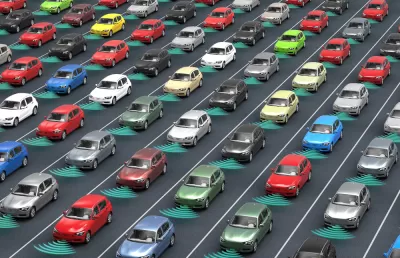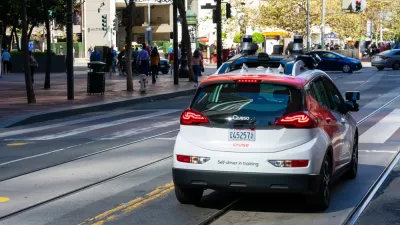Self-driving cars are likely to become part of the urban landscape in the future, and they have the potential to drastically alter urban environments—in good and bad ways.

"Unless cities pay close attention to how self-driving cars will shape their futures, experts say, they could easily repeat, and exacerbate, mistakes of the past," writes Katherine Shaver.
Widespread use of autonomous vehicles will not happen, realistically, for at least a couple decades, say experts. But planners, designers, and architects are thinking ahead to how the new technology could change land use and travel patterns, says Shaver.
"For example, because driverless vehicles will drop off passengers and move on, prime real estate now consumed by vast parking lots and unsightly garages could be freed up for more housing, parks, public plazas and open space, planners say," writes Shaver. In addition, streets would open up, making room for bike lanes and wider sidewalks.
Still, many questions remain about the long-term impacts of self-driving vehicles, with some predictions suggesting that they will not solve the parking, housing, and transportation problems of cities. If these vehicles make car travel easier, people might travel more, eschew transit, and decide to live farther out, with the result being increased sprawl.
"Even so, some planners are considering ways that governments could discourage such behavior, for example, via a per-mile tax to make driverless vehicle passengers feel and bear the costs of longer trips. Such a tax, supporters say, also might discourage empty vehicles from adding to traffic congestion by roaming streets in search of passengers," notes Shaver.
FULL STORY: City planners eye self-driving vehicles to correct mistakes of the 20th-century auto

Study: Maui’s Plan to Convert Vacation Rentals to Long-Term Housing Could Cause Nearly $1 Billion Economic Loss
The plan would reduce visitor accommodation by 25,% resulting in 1,900 jobs lost.

North Texas Transit Leaders Tout Benefits of TOD for Growing Region
At a summit focused on transit-oriented development, policymakers discussed how North Texas’ expanded light rail system can serve as a tool for economic growth.

Using Old Oil and Gas Wells for Green Energy Storage
Penn State researchers have found that repurposing abandoned oil and gas wells for geothermal-assisted compressed-air energy storage can boost efficiency, reduce environmental risks, and support clean energy and job transitions.

Private Donations Propel Early Restoration of Palisades Playground
Los Angeles has secured over $1.3 million in private funding to restore the Pacific Palisades playground months ahead of schedule, creating a modern, accessible space that supports community healing after recent wildfires.

From Blight to Benefit: Early Results From California’s Equitable Cleanup Program
The Equitable Community Revitalization Grant (ECRG) program is reshaping brownfield redevelopment by prioritizing projects in low-income and environmental justice communities, emphasizing equity, transparency, and community benefits.

Planting Relief: Tackling Las Vegas Heat One Tree at a Time
Nevada Plants, a Las Vegas-based nonprofit, is combating the city’s extreme urban heat by giving away trees to residents in underserved neighborhoods, promoting shade, sustainability, and community health.
Urban Design for Planners 1: Software Tools
This six-course series explores essential urban design concepts using open source software and equips planners with the tools they need to participate fully in the urban design process.
Planning for Universal Design
Learn the tools for implementing Universal Design in planning regulations.
Ascent Environmental
Borough of Carlisle
Institute for Housing and Urban Development Studies (IHS)
City of Grandview
Harvard GSD Executive Education
Toledo-Lucas County Plan Commissions
Salt Lake City
NYU Wagner Graduate School of Public Service





























